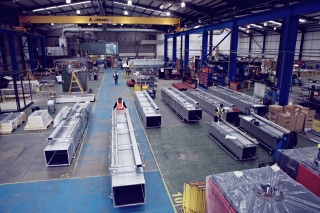Exploiting the benefits of off-site pre-fabrication

Off-site, pre-fabrication of building engineering services will be an increasingly important way of tackling skills shortages and meeting tough performance targets, according to the Building & Engineering Services Association (B&ES).
Contractors are increasingly adopting off-site construction techniques in a bid to improve quality reduce defects, cut costs, reduce waste and speed up delivery of projects.
Off-site prefabrication is also helping contractors deal with the widespread skills shortages that are making it difficult to keep pace with growing demand. Assembling more building engineering modules off-site provides welcome breathing space as contractors can deliver projects more efficiently and with fewer on-site workers.
Pre-fabrication now accounts for more than 4% of the £100 billion construction sector’s annual turnover and up to 80% of the construction cost of some projects. Off-site technologies are also being used to address some of the industry’s most pressing challenges, including the need for new housing and more sustainable construction.
It is challenging because it requires the adoption of digital design and construction methods, including building information modelling (BIM), to make it fully successful, but leading engineers believe it is the industry’s best hope for the future.
Jigsaw
‘M&E design and install is now a million miles away from how we used to do things,’ says B&ES president Jim Marner. ‘BIM is absolutely the way forward because it is driving the use of off-site fabrication, which allows us to put projects together like a jigsaw.’
He points out that off-site modules can be produced with all the components manufactured to within 2 or 3 mm tolerance, making on-site construction rapid and accurate.
‘We don’t give builders the option anymore; this is the way we do things as a business,’ says Mr Marner, who is also business-development director for Shepherd Engineering Services (SES). ‘When you buy a car you expect it to look brand new, but when we hand over a building it often looks like someone has been kicking it around. Off-site fabrication is the way to present a far better finished product.’
Building sites are notoriously inefficient in the use of labour and materials. Studies in the UK have shown that site labour is considerably less productive than factory-based working. In some cases the useful activity on site can be below 50% of full potential — contributing to the low productivity issues identified by the Chancellor George Osborne in his report ‘Fixing the foundations: creating a more prosperous nation’.
Construction-related activities also contribute an estimated 70 million tonnes of waste to landfill every year in the UK, and it is estimated that around 13% of materials delivered to site are never used. It is much easier to manage the supply, use and storage of materials in a controlled, factory environment. Also, any waste can be more easily collected and reused or recycled as part of the off-site process.
To support the growth in off-site working, B&ES Publications has launched a first-of-its-kind guide to off-site construction, in partnership with the trade association Buildoffsite.
 |
| The future of building services will for the most part involve factory-made and tested solutions installed on site to the requirements set out in an information model — Richard Ogden, former chairman of Buildoffsite. |
The guide provides practical support for the effective use of off-site construction methods. The content is of use not only to contractors but to all those involved in the built environment — including architects, engineers, installers and clients.
By using the B&ES guide, construction professionals can reduce the risks associated with building performance, productivity, health and safety, wastage and quality on a huge variety of projects from commercial and industrial buildings to healthcare and educational establishments.
Nigel Fraser, the guide’s author, says it was a great opportunity to transfer learning from a range of projects. ‘Whilst it focuses upon building-services aspects it also provides a general guide to exploiting off-site construction effectively. It has brought together experts from building and engineering services, architecture, construction and manufacturing sectors.
Collaboration
‘This has been facilitated through the collaboration of two organisations. B&ES and Buildoffsite, which are working to improve skills in this area.’
Richard Ogden, chairman of Buildoffsite, adds, ‘Building and engineering services are essential components of most modern buildings. What clients want are services that perform as specified and work correctly first time. From my own experience as a client I understand the importance of certainty of manufacturing excellence and the simplest possible installation and maintenance.
‘The future of building services will for the most part involve factory-made-and-tested solutions installed on site to the requirements set out in an information model,’ he says.
‘To support this direction, I’m delighted that B&ES Publications has produced this excellent off-site construction guide for the construction sector. It is the route map that will provide the information to assist the building-services industry to become the vanguard in the delivery of “right-first-time” solutions for their customers.’
The new guidance highlights the fact that the off-site approach has a number of wider economic, environmental and social benefits. A factory is a much safer and more comfortable working environment than a building site exposed to the vagaries of British weather. It is also easier in a factory to set up quality-control procedures, with testing, prototyping and checking. For example, electrical and water connections can be fully tested before leaving the factory.
There are also far fewer calls backs to make good defects after completion. This not only cuts costs, but also improves end user satisfaction.
There are also benefits for people living close to construction sites because there is less disruption and noise due to reduced time and activity on site and fewer deliveries. In some instances lorry movements have been shown to be reduced by 90% if a project is largely produced off-site.
It is also clear that the growth of off-site working has reduced health-and-safety problems. In some cases, it is pressure from legislation that has prompted many builders to increase their use of off-site processes to improve worker safety. Working at heights has always been a big area of concern for the industry — with the use of scaffolding on site a particular problem. Now many off-site-manufactured schemes eliminate the need for scaffolding completely by integrating cladding in the factory.
 |
| Off-site manufacture in action — this is NG Bailey’s 7000 m2 facility. |
Thermal and acoustic performance of a building can also be improved when modules are assembled off-site because operatives can be better trained and supervised in the inclusion of insulation and air barriers, and their work more easily checked and tested in factory conditions.
Factory employment tends to be more stable and long-term than site-based employment, which is intrinsically transient. As a result, factory-based employers are more willing to invest in training for their workforce. Furthermore, to function efficiently, off-site fabrication requires high levels of skill and flexibility in the workforce. This necessitates greater training, which will contribute to our efforts to improve skill levels across the industry.
Off-site construction is not a complete solution to the industry’s skills problems, but it is a hugely beneficial way of ensuring we extract maximum potential from the workforce we have available while also dramatically improving productivity and quality.
However, the industry must, in parallel, invest in recruiting and training to ensure it has a workforce equipped with new skills to deal with more modern working techniques, in general, and to handle the technology required to make off-site and digital construction function well.
To order B&ES Publications’ off-site construction guide, call 01768 860405, email info@ b-espublications.co.uk or visit the link below.







